Motives for University Students to Travel Overseas
VerifiedAdded on 2023/06/13
|8
|3095
|209
AI Summary
This report explores the motives for university students to travel overseas, including the reasons why male and female students travel, the differences and similarities between them, and the economic impact of their travels. The report draws on a literature review and survey data from a sample of 16 students. The results show that students travel overseas for a variety of reasons, including family visits, sports, socialization, adventure, and study. Both male and female students travel for similar reasons, such as socializing with new people and experiencing new cultures, but there are also some differences in their motives. The report concludes that economic growth is realized by the hosting countries as a result of the students' travels.
Contribute Materials
Your contribution can guide someone’s learning journey. Share your
documents today.
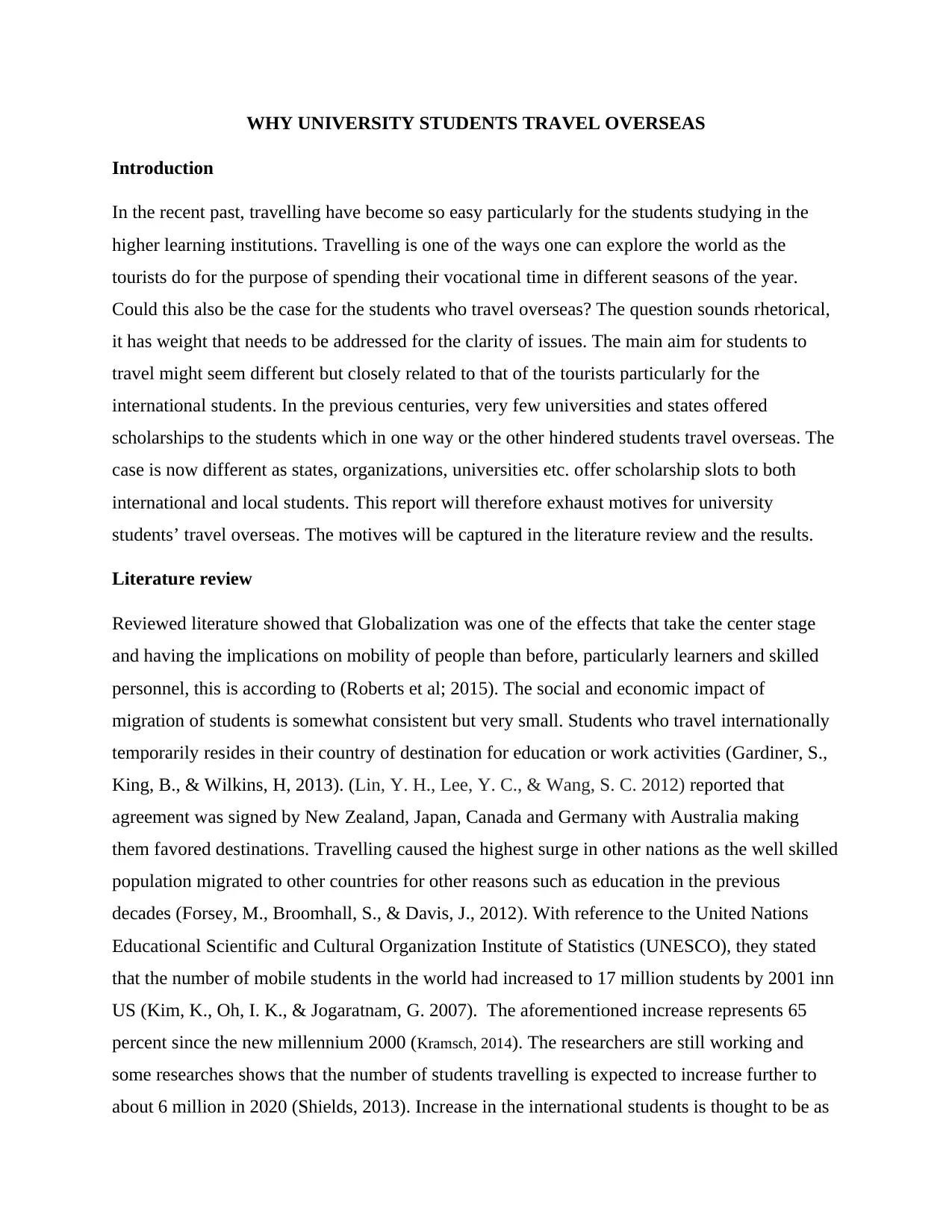
WHY UNIVERSITY STUDENTS TRAVEL OVERSEAS
Introduction
In the recent past, travelling have become so easy particularly for the students studying in the
higher learning institutions. Travelling is one of the ways one can explore the world as the
tourists do for the purpose of spending their vocational time in different seasons of the year.
Could this also be the case for the students who travel overseas? The question sounds rhetorical,
it has weight that needs to be addressed for the clarity of issues. The main aim for students to
travel might seem different but closely related to that of the tourists particularly for the
international students. In the previous centuries, very few universities and states offered
scholarships to the students which in one way or the other hindered students travel overseas. The
case is now different as states, organizations, universities etc. offer scholarship slots to both
international and local students. This report will therefore exhaust motives for university
students’ travel overseas. The motives will be captured in the literature review and the results.
Literature review
Reviewed literature showed that Globalization was one of the effects that take the center stage
and having the implications on mobility of people than before, particularly learners and skilled
personnel, this is according to (Roberts et al; 2015). The social and economic impact of
migration of students is somewhat consistent but very small. Students who travel internationally
temporarily resides in their country of destination for education or work activities (Gardiner, S.,
King, B., & Wilkins, H, 2013). (Lin, Y. H., Lee, Y. C., & Wang, S. C. 2012) reported that
agreement was signed by New Zealand, Japan, Canada and Germany with Australia making
them favored destinations. Travelling caused the highest surge in other nations as the well skilled
population migrated to other countries for other reasons such as education in the previous
decades (Forsey, M., Broomhall, S., & Davis, J., 2012). With reference to the United Nations
Educational Scientific and Cultural Organization Institute of Statistics (UNESCO), they stated
that the number of mobile students in the world had increased to 17 million students by 2001 inn
US (Kim, K., Oh, I. K., & Jogaratnam, G. 2007). The aforementioned increase represents 65
percent since the new millennium 2000 (Kramsch, 2014). The researchers are still working and
some researches shows that the number of students travelling is expected to increase further to
about 6 million in 2020 (Shields, 2013). Increase in the international students is thought to be as
Introduction
In the recent past, travelling have become so easy particularly for the students studying in the
higher learning institutions. Travelling is one of the ways one can explore the world as the
tourists do for the purpose of spending their vocational time in different seasons of the year.
Could this also be the case for the students who travel overseas? The question sounds rhetorical,
it has weight that needs to be addressed for the clarity of issues. The main aim for students to
travel might seem different but closely related to that of the tourists particularly for the
international students. In the previous centuries, very few universities and states offered
scholarships to the students which in one way or the other hindered students travel overseas. The
case is now different as states, organizations, universities etc. offer scholarship slots to both
international and local students. This report will therefore exhaust motives for university
students’ travel overseas. The motives will be captured in the literature review and the results.
Literature review
Reviewed literature showed that Globalization was one of the effects that take the center stage
and having the implications on mobility of people than before, particularly learners and skilled
personnel, this is according to (Roberts et al; 2015). The social and economic impact of
migration of students is somewhat consistent but very small. Students who travel internationally
temporarily resides in their country of destination for education or work activities (Gardiner, S.,
King, B., & Wilkins, H, 2013). (Lin, Y. H., Lee, Y. C., & Wang, S. C. 2012) reported that
agreement was signed by New Zealand, Japan, Canada and Germany with Australia making
them favored destinations. Travelling caused the highest surge in other nations as the well skilled
population migrated to other countries for other reasons such as education in the previous
decades (Forsey, M., Broomhall, S., & Davis, J., 2012). With reference to the United Nations
Educational Scientific and Cultural Organization Institute of Statistics (UNESCO), they stated
that the number of mobile students in the world had increased to 17 million students by 2001 inn
US (Kim, K., Oh, I. K., & Jogaratnam, G. 2007). The aforementioned increase represents 65
percent since the new millennium 2000 (Kramsch, 2014). The researchers are still working and
some researches shows that the number of students travelling is expected to increase further to
about 6 million in 2020 (Shields, 2013). Increase in the international students is thought to be as
Secure Best Marks with AI Grader
Need help grading? Try our AI Grader for instant feedback on your assignments.
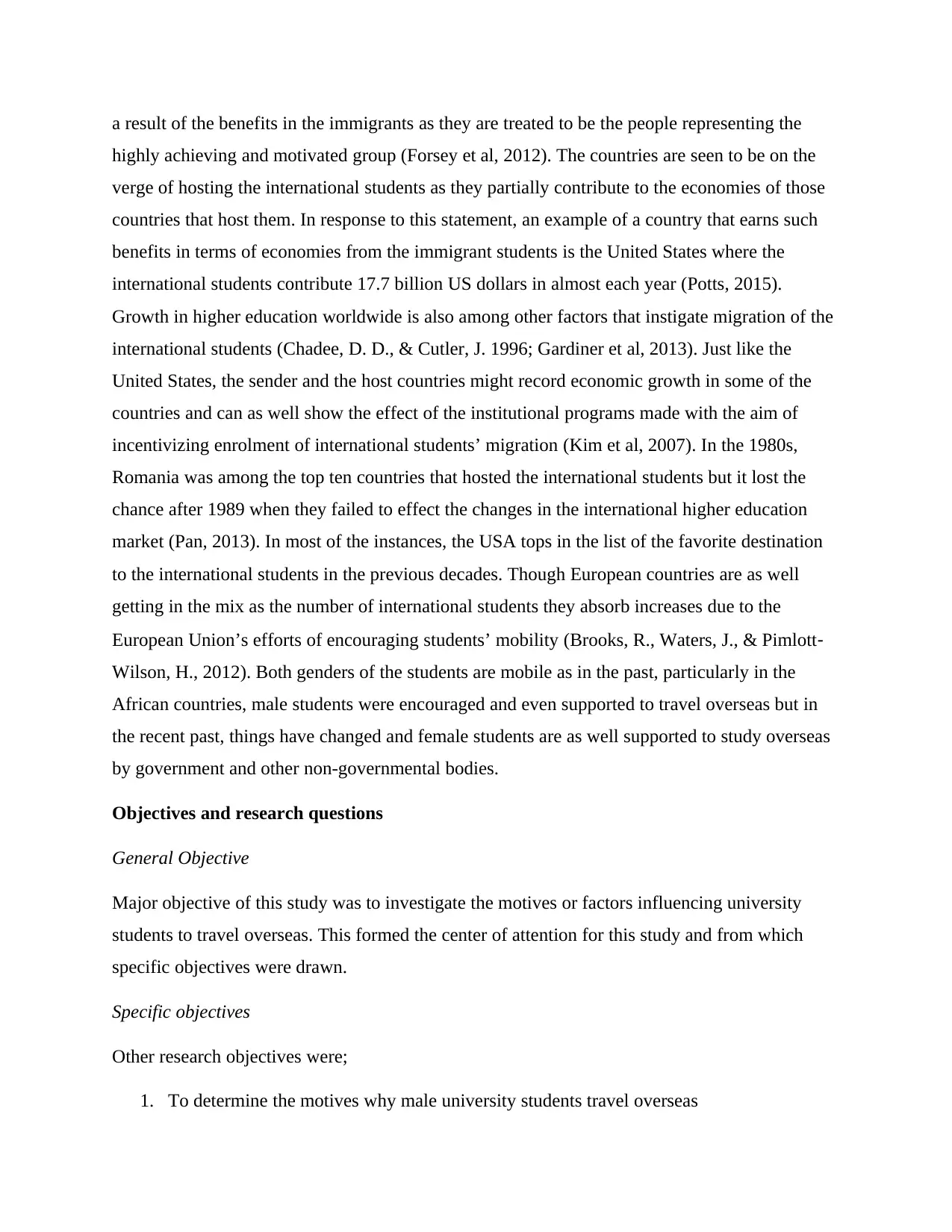
a result of the benefits in the immigrants as they are treated to be the people representing the
highly achieving and motivated group (Forsey et al, 2012). The countries are seen to be on the
verge of hosting the international students as they partially contribute to the economies of those
countries that host them. In response to this statement, an example of a country that earns such
benefits in terms of economies from the immigrant students is the United States where the
international students contribute 17.7 billion US dollars in almost each year (Potts, 2015).
Growth in higher education worldwide is also among other factors that instigate migration of the
international students (Chadee, D. D., & Cutler, J. 1996; Gardiner et al, 2013). Just like the
United States, the sender and the host countries might record economic growth in some of the
countries and can as well show the effect of the institutional programs made with the aim of
incentivizing enrolment of international students’ migration (Kim et al, 2007). In the 1980s,
Romania was among the top ten countries that hosted the international students but it lost the
chance after 1989 when they failed to effect the changes in the international higher education
market (Pan, 2013). In most of the instances, the USA tops in the list of the favorite destination
to the international students in the previous decades. Though European countries are as well
getting in the mix as the number of international students they absorb increases due to the
European Union’s efforts of encouraging students’ mobility (Brooks, R., Waters, J., & Pimlott‐
Wilson, H., 2012). Both genders of the students are mobile as in the past, particularly in the
African countries, male students were encouraged and even supported to travel overseas but in
the recent past, things have changed and female students are as well supported to study overseas
by government and other non-governmental bodies.
Objectives and research questions
General Objective
Major objective of this study was to investigate the motives or factors influencing university
students to travel overseas. This formed the center of attention for this study and from which
specific objectives were drawn.
Specific objectives
Other research objectives were;
1. To determine the motives why male university students travel overseas
highly achieving and motivated group (Forsey et al, 2012). The countries are seen to be on the
verge of hosting the international students as they partially contribute to the economies of those
countries that host them. In response to this statement, an example of a country that earns such
benefits in terms of economies from the immigrant students is the United States where the
international students contribute 17.7 billion US dollars in almost each year (Potts, 2015).
Growth in higher education worldwide is also among other factors that instigate migration of the
international students (Chadee, D. D., & Cutler, J. 1996; Gardiner et al, 2013). Just like the
United States, the sender and the host countries might record economic growth in some of the
countries and can as well show the effect of the institutional programs made with the aim of
incentivizing enrolment of international students’ migration (Kim et al, 2007). In the 1980s,
Romania was among the top ten countries that hosted the international students but it lost the
chance after 1989 when they failed to effect the changes in the international higher education
market (Pan, 2013). In most of the instances, the USA tops in the list of the favorite destination
to the international students in the previous decades. Though European countries are as well
getting in the mix as the number of international students they absorb increases due to the
European Union’s efforts of encouraging students’ mobility (Brooks, R., Waters, J., & Pimlott‐
Wilson, H., 2012). Both genders of the students are mobile as in the past, particularly in the
African countries, male students were encouraged and even supported to travel overseas but in
the recent past, things have changed and female students are as well supported to study overseas
by government and other non-governmental bodies.
Objectives and research questions
General Objective
Major objective of this study was to investigate the motives or factors influencing university
students to travel overseas. This formed the center of attention for this study and from which
specific objectives were drawn.
Specific objectives
Other research objectives were;
1. To determine the motives why male university students travel overseas
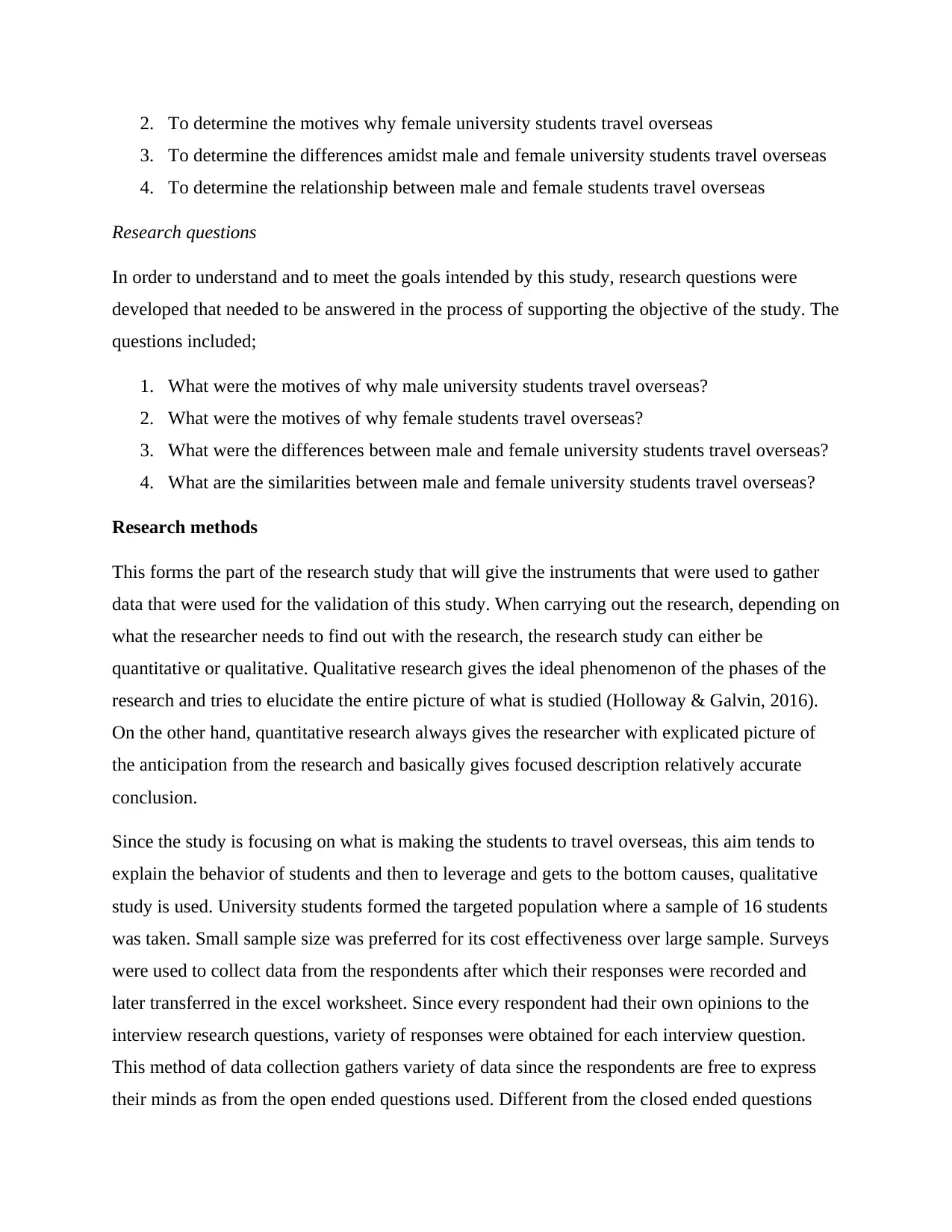
2. To determine the motives why female university students travel overseas
3. To determine the differences amidst male and female university students travel overseas
4. To determine the relationship between male and female students travel overseas
Research questions
In order to understand and to meet the goals intended by this study, research questions were
developed that needed to be answered in the process of supporting the objective of the study. The
questions included;
1. What were the motives of why male university students travel overseas?
2. What were the motives of why female students travel overseas?
3. What were the differences between male and female university students travel overseas?
4. What are the similarities between male and female university students travel overseas?
Research methods
This forms the part of the research study that will give the instruments that were used to gather
data that were used for the validation of this study. When carrying out the research, depending on
what the researcher needs to find out with the research, the research study can either be
quantitative or qualitative. Qualitative research gives the ideal phenomenon of the phases of the
research and tries to elucidate the entire picture of what is studied (Holloway & Galvin, 2016).
On the other hand, quantitative research always gives the researcher with explicated picture of
the anticipation from the research and basically gives focused description relatively accurate
conclusion.
Since the study is focusing on what is making the students to travel overseas, this aim tends to
explain the behavior of students and then to leverage and gets to the bottom causes, qualitative
study is used. University students formed the targeted population where a sample of 16 students
was taken. Small sample size was preferred for its cost effectiveness over large sample. Surveys
were used to collect data from the respondents after which their responses were recorded and
later transferred in the excel worksheet. Since every respondent had their own opinions to the
interview research questions, variety of responses were obtained for each interview question.
This method of data collection gathers variety of data since the respondents are free to express
their minds as from the open ended questions used. Different from the closed ended questions
3. To determine the differences amidst male and female university students travel overseas
4. To determine the relationship between male and female students travel overseas
Research questions
In order to understand and to meet the goals intended by this study, research questions were
developed that needed to be answered in the process of supporting the objective of the study. The
questions included;
1. What were the motives of why male university students travel overseas?
2. What were the motives of why female students travel overseas?
3. What were the differences between male and female university students travel overseas?
4. What are the similarities between male and female university students travel overseas?
Research methods
This forms the part of the research study that will give the instruments that were used to gather
data that were used for the validation of this study. When carrying out the research, depending on
what the researcher needs to find out with the research, the research study can either be
quantitative or qualitative. Qualitative research gives the ideal phenomenon of the phases of the
research and tries to elucidate the entire picture of what is studied (Holloway & Galvin, 2016).
On the other hand, quantitative research always gives the researcher with explicated picture of
the anticipation from the research and basically gives focused description relatively accurate
conclusion.
Since the study is focusing on what is making the students to travel overseas, this aim tends to
explain the behavior of students and then to leverage and gets to the bottom causes, qualitative
study is used. University students formed the targeted population where a sample of 16 students
was taken. Small sample size was preferred for its cost effectiveness over large sample. Surveys
were used to collect data from the respondents after which their responses were recorded and
later transferred in the excel worksheet. Since every respondent had their own opinions to the
interview research questions, variety of responses were obtained for each interview question.
This method of data collection gathers variety of data since the respondents are free to express
their minds as from the open ended questions used. Different from the closed ended questions
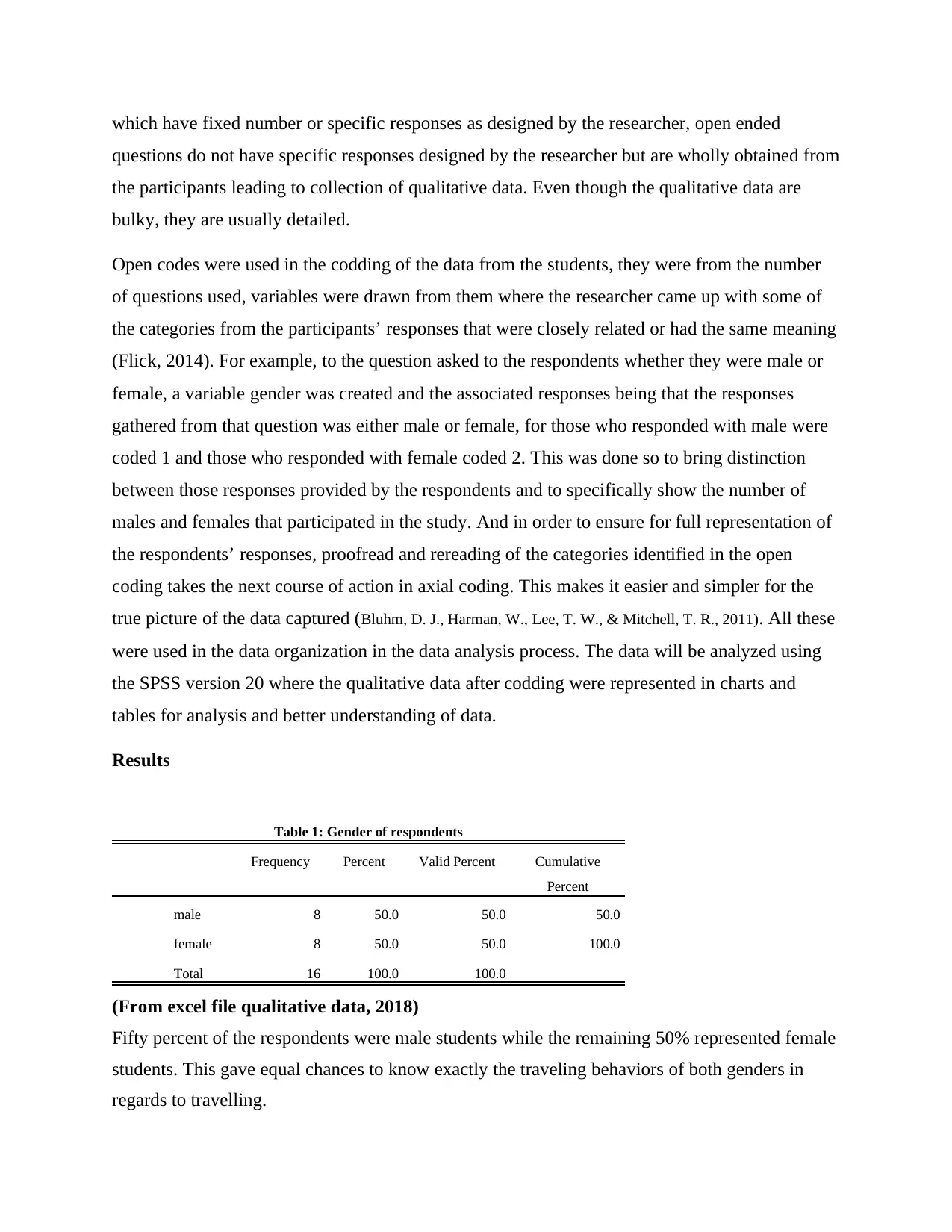
which have fixed number or specific responses as designed by the researcher, open ended
questions do not have specific responses designed by the researcher but are wholly obtained from
the participants leading to collection of qualitative data. Even though the qualitative data are
bulky, they are usually detailed.
Open codes were used in the codding of the data from the students, they were from the number
of questions used, variables were drawn from them where the researcher came up with some of
the categories from the participants’ responses that were closely related or had the same meaning
(Flick, 2014). For example, to the question asked to the respondents whether they were male or
female, a variable gender was created and the associated responses being that the responses
gathered from that question was either male or female, for those who responded with male were
coded 1 and those who responded with female coded 2. This was done so to bring distinction
between those responses provided by the respondents and to specifically show the number of
males and females that participated in the study. And in order to ensure for full representation of
the respondents’ responses, proofread and rereading of the categories identified in the open
coding takes the next course of action in axial coding. This makes it easier and simpler for the
true picture of the data captured (Bluhm, D. J., Harman, W., Lee, T. W., & Mitchell, T. R., 2011). All these
were used in the data organization in the data analysis process. The data will be analyzed using
the SPSS version 20 where the qualitative data after codding were represented in charts and
tables for analysis and better understanding of data.
Results
Table 1: Gender of respondents
Frequency Percent Valid Percent Cumulative
Percent
male 8 50.0 50.0 50.0
female 8 50.0 50.0 100.0
Total 16 100.0 100.0
(From excel file qualitative data, 2018)
Fifty percent of the respondents were male students while the remaining 50% represented female
students. This gave equal chances to know exactly the traveling behaviors of both genders in
regards to travelling.
questions do not have specific responses designed by the researcher but are wholly obtained from
the participants leading to collection of qualitative data. Even though the qualitative data are
bulky, they are usually detailed.
Open codes were used in the codding of the data from the students, they were from the number
of questions used, variables were drawn from them where the researcher came up with some of
the categories from the participants’ responses that were closely related or had the same meaning
(Flick, 2014). For example, to the question asked to the respondents whether they were male or
female, a variable gender was created and the associated responses being that the responses
gathered from that question was either male or female, for those who responded with male were
coded 1 and those who responded with female coded 2. This was done so to bring distinction
between those responses provided by the respondents and to specifically show the number of
males and females that participated in the study. And in order to ensure for full representation of
the respondents’ responses, proofread and rereading of the categories identified in the open
coding takes the next course of action in axial coding. This makes it easier and simpler for the
true picture of the data captured (Bluhm, D. J., Harman, W., Lee, T. W., & Mitchell, T. R., 2011). All these
were used in the data organization in the data analysis process. The data will be analyzed using
the SPSS version 20 where the qualitative data after codding were represented in charts and
tables for analysis and better understanding of data.
Results
Table 1: Gender of respondents
Frequency Percent Valid Percent Cumulative
Percent
male 8 50.0 50.0 50.0
female 8 50.0 50.0 100.0
Total 16 100.0 100.0
(From excel file qualitative data, 2018)
Fifty percent of the respondents were male students while the remaining 50% represented female
students. This gave equal chances to know exactly the traveling behaviors of both genders in
regards to travelling.
Secure Best Marks with AI Grader
Need help grading? Try our AI Grader for instant feedback on your assignments.
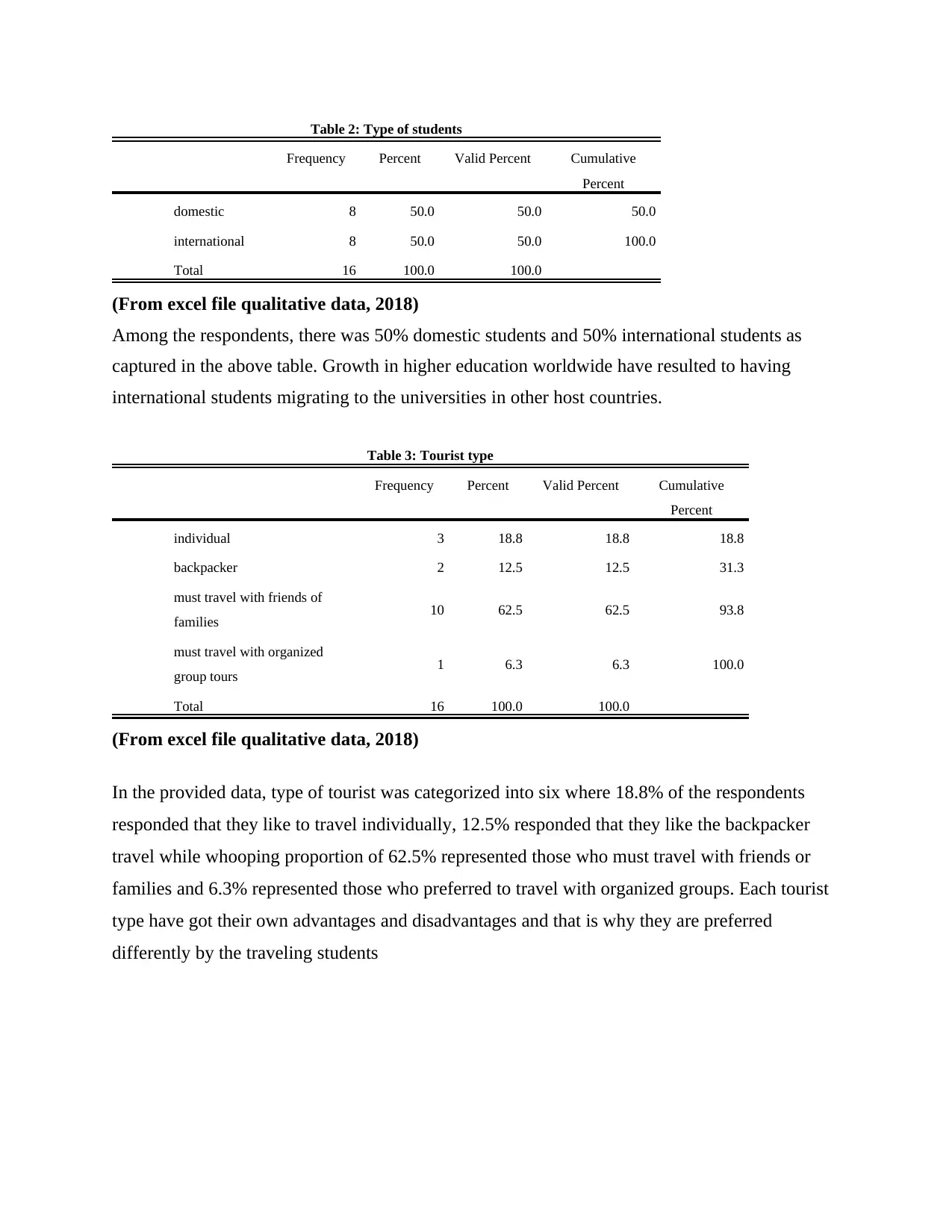
Table 2: Type of students
Frequency Percent Valid Percent Cumulative
Percent
domestic 8 50.0 50.0 50.0
international 8 50.0 50.0 100.0
Total 16 100.0 100.0
(From excel file qualitative data, 2018)
Among the respondents, there was 50% domestic students and 50% international students as
captured in the above table. Growth in higher education worldwide have resulted to having
international students migrating to the universities in other host countries.
Table 3: Tourist type
Frequency Percent Valid Percent Cumulative
Percent
individual 3 18.8 18.8 18.8
backpacker 2 12.5 12.5 31.3
must travel with friends of
families 10 62.5 62.5 93.8
must travel with organized
group tours 1 6.3 6.3 100.0
Total 16 100.0 100.0
(From excel file qualitative data, 2018)
In the provided data, type of tourist was categorized into six where 18.8% of the respondents
responded that they like to travel individually, 12.5% responded that they like the backpacker
travel while whooping proportion of 62.5% represented those who must travel with friends or
families and 6.3% represented those who preferred to travel with organized groups. Each tourist
type have got their own advantages and disadvantages and that is why they are preferred
differently by the traveling students
Frequency Percent Valid Percent Cumulative
Percent
domestic 8 50.0 50.0 50.0
international 8 50.0 50.0 100.0
Total 16 100.0 100.0
(From excel file qualitative data, 2018)
Among the respondents, there was 50% domestic students and 50% international students as
captured in the above table. Growth in higher education worldwide have resulted to having
international students migrating to the universities in other host countries.
Table 3: Tourist type
Frequency Percent Valid Percent Cumulative
Percent
individual 3 18.8 18.8 18.8
backpacker 2 12.5 12.5 31.3
must travel with friends of
families 10 62.5 62.5 93.8
must travel with organized
group tours 1 6.3 6.3 100.0
Total 16 100.0 100.0
(From excel file qualitative data, 2018)
In the provided data, type of tourist was categorized into six where 18.8% of the respondents
responded that they like to travel individually, 12.5% responded that they like the backpacker
travel while whooping proportion of 62.5% represented those who must travel with friends or
families and 6.3% represented those who preferred to travel with organized groups. Each tourist
type have got their own advantages and disadvantages and that is why they are preferred
differently by the traveling students
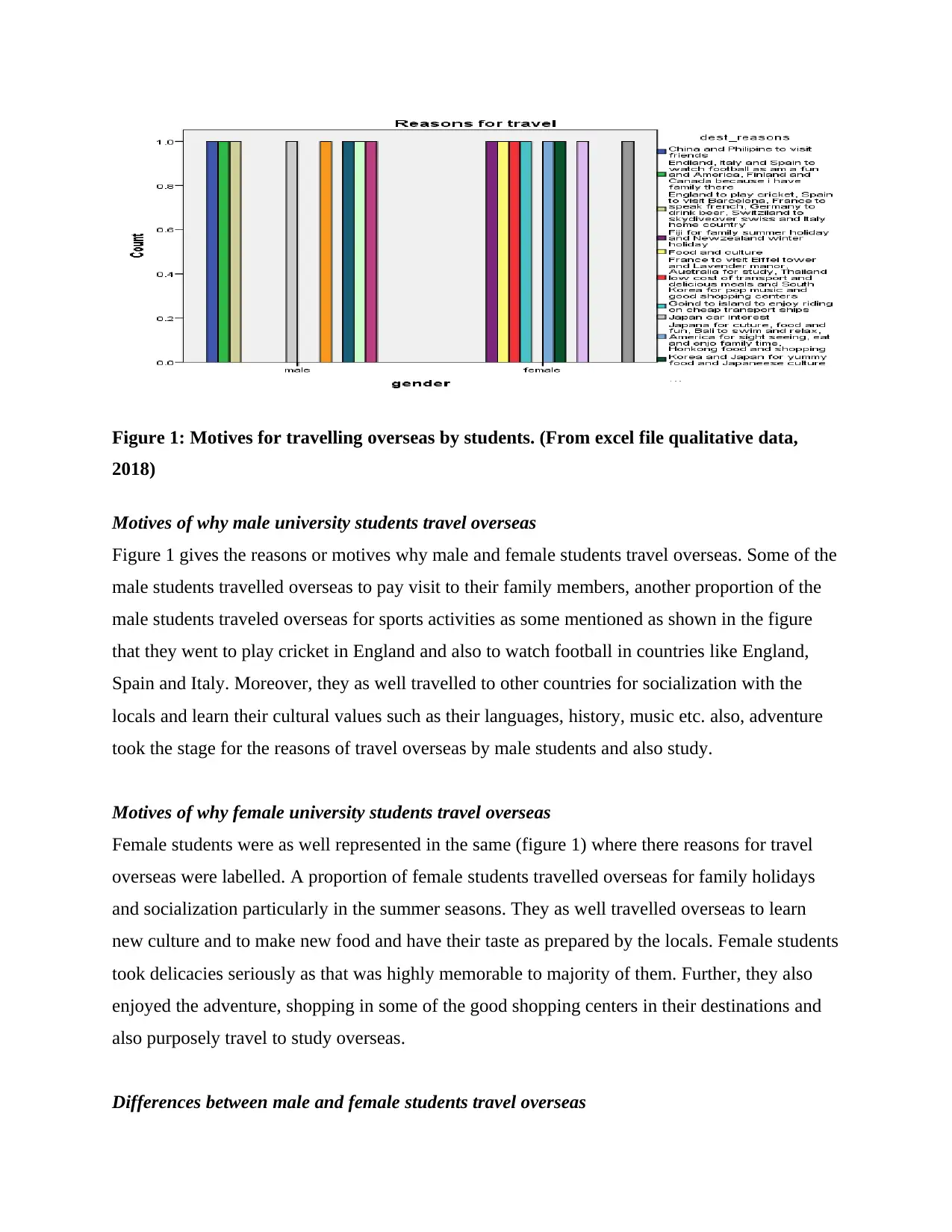
Figure 1: Motives for travelling overseas by students. (From excel file qualitative data,
2018)
Motives of why male university students travel overseas
Figure 1 gives the reasons or motives why male and female students travel overseas. Some of the
male students travelled overseas to pay visit to their family members, another proportion of the
male students traveled overseas for sports activities as some mentioned as shown in the figure
that they went to play cricket in England and also to watch football in countries like England,
Spain and Italy. Moreover, they as well travelled to other countries for socialization with the
locals and learn their cultural values such as their languages, history, music etc. also, adventure
took the stage for the reasons of travel overseas by male students and also study.
Motives of why female university students travel overseas
Female students were as well represented in the same (figure 1) where there reasons for travel
overseas were labelled. A proportion of female students travelled overseas for family holidays
and socialization particularly in the summer seasons. They as well travelled overseas to learn
new culture and to make new food and have their taste as prepared by the locals. Female students
took delicacies seriously as that was highly memorable to majority of them. Further, they also
enjoyed the adventure, shopping in some of the good shopping centers in their destinations and
also purposely travel to study overseas.
Differences between male and female students travel overseas
2018)
Motives of why male university students travel overseas
Figure 1 gives the reasons or motives why male and female students travel overseas. Some of the
male students travelled overseas to pay visit to their family members, another proportion of the
male students traveled overseas for sports activities as some mentioned as shown in the figure
that they went to play cricket in England and also to watch football in countries like England,
Spain and Italy. Moreover, they as well travelled to other countries for socialization with the
locals and learn their cultural values such as their languages, history, music etc. also, adventure
took the stage for the reasons of travel overseas by male students and also study.
Motives of why female university students travel overseas
Female students were as well represented in the same (figure 1) where there reasons for travel
overseas were labelled. A proportion of female students travelled overseas for family holidays
and socialization particularly in the summer seasons. They as well travelled overseas to learn
new culture and to make new food and have their taste as prepared by the locals. Female students
took delicacies seriously as that was highly memorable to majority of them. Further, they also
enjoyed the adventure, shopping in some of the good shopping centers in their destinations and
also purposely travel to study overseas.
Differences between male and female students travel overseas
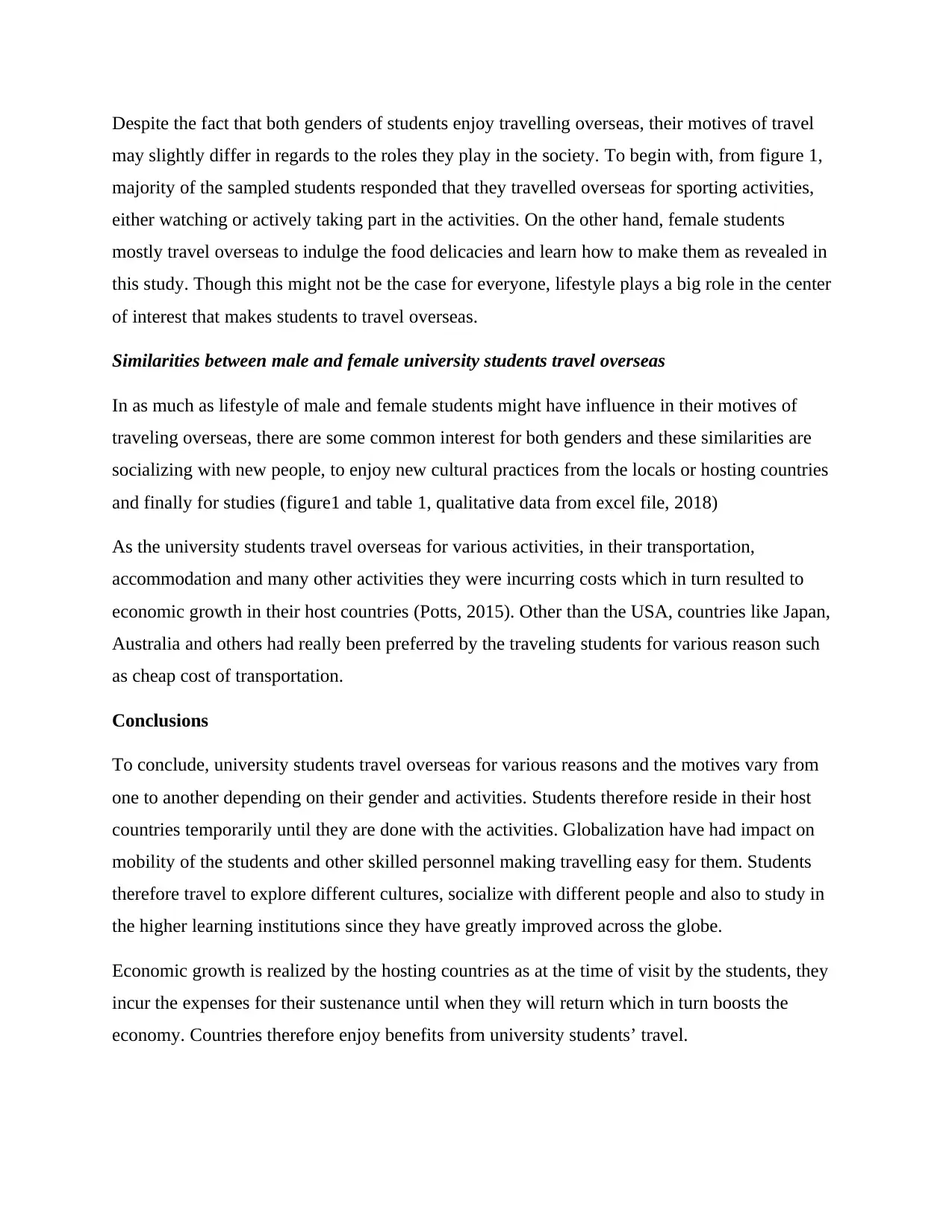
Despite the fact that both genders of students enjoy travelling overseas, their motives of travel
may slightly differ in regards to the roles they play in the society. To begin with, from figure 1,
majority of the sampled students responded that they travelled overseas for sporting activities,
either watching or actively taking part in the activities. On the other hand, female students
mostly travel overseas to indulge the food delicacies and learn how to make them as revealed in
this study. Though this might not be the case for everyone, lifestyle plays a big role in the center
of interest that makes students to travel overseas.
Similarities between male and female university students travel overseas
In as much as lifestyle of male and female students might have influence in their motives of
traveling overseas, there are some common interest for both genders and these similarities are
socializing with new people, to enjoy new cultural practices from the locals or hosting countries
and finally for studies (figure1 and table 1, qualitative data from excel file, 2018)
As the university students travel overseas for various activities, in their transportation,
accommodation and many other activities they were incurring costs which in turn resulted to
economic growth in their host countries (Potts, 2015). Other than the USA, countries like Japan,
Australia and others had really been preferred by the traveling students for various reason such
as cheap cost of transportation.
Conclusions
To conclude, university students travel overseas for various reasons and the motives vary from
one to another depending on their gender and activities. Students therefore reside in their host
countries temporarily until they are done with the activities. Globalization have had impact on
mobility of the students and other skilled personnel making travelling easy for them. Students
therefore travel to explore different cultures, socialize with different people and also to study in
the higher learning institutions since they have greatly improved across the globe.
Economic growth is realized by the hosting countries as at the time of visit by the students, they
incur the expenses for their sustenance until when they will return which in turn boosts the
economy. Countries therefore enjoy benefits from university students’ travel.
may slightly differ in regards to the roles they play in the society. To begin with, from figure 1,
majority of the sampled students responded that they travelled overseas for sporting activities,
either watching or actively taking part in the activities. On the other hand, female students
mostly travel overseas to indulge the food delicacies and learn how to make them as revealed in
this study. Though this might not be the case for everyone, lifestyle plays a big role in the center
of interest that makes students to travel overseas.
Similarities between male and female university students travel overseas
In as much as lifestyle of male and female students might have influence in their motives of
traveling overseas, there are some common interest for both genders and these similarities are
socializing with new people, to enjoy new cultural practices from the locals or hosting countries
and finally for studies (figure1 and table 1, qualitative data from excel file, 2018)
As the university students travel overseas for various activities, in their transportation,
accommodation and many other activities they were incurring costs which in turn resulted to
economic growth in their host countries (Potts, 2015). Other than the USA, countries like Japan,
Australia and others had really been preferred by the traveling students for various reason such
as cheap cost of transportation.
Conclusions
To conclude, university students travel overseas for various reasons and the motives vary from
one to another depending on their gender and activities. Students therefore reside in their host
countries temporarily until they are done with the activities. Globalization have had impact on
mobility of the students and other skilled personnel making travelling easy for them. Students
therefore travel to explore different cultures, socialize with different people and also to study in
the higher learning institutions since they have greatly improved across the globe.
Economic growth is realized by the hosting countries as at the time of visit by the students, they
incur the expenses for their sustenance until when they will return which in turn boosts the
economy. Countries therefore enjoy benefits from university students’ travel.
Paraphrase This Document
Need a fresh take? Get an instant paraphrase of this document with our AI Paraphraser
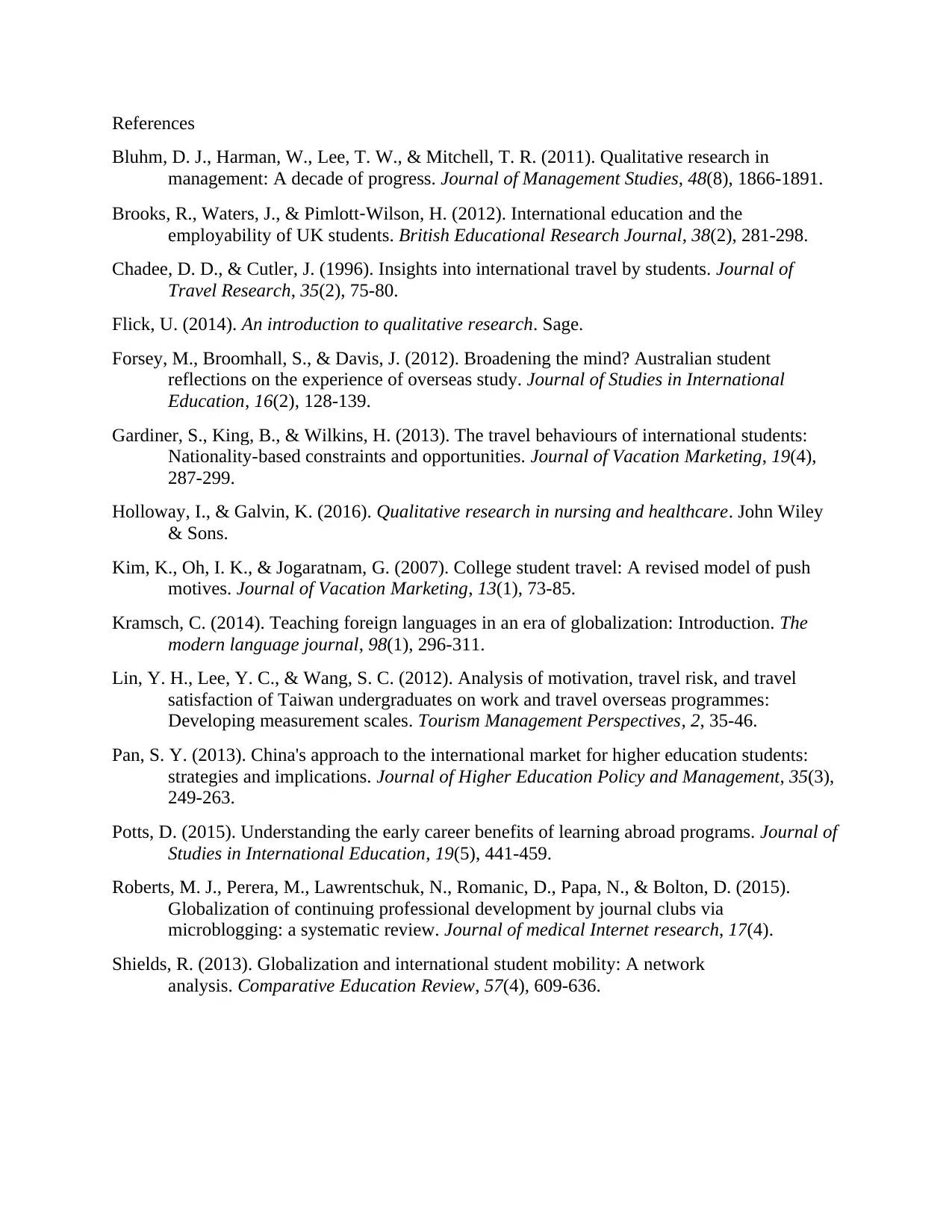
References
Bluhm, D. J., Harman, W., Lee, T. W., & Mitchell, T. R. (2011). Qualitative research in
management: A decade of progress. Journal of Management Studies, 48(8), 1866-1891.
Brooks, R., Waters, J., & Pimlott‐Wilson, H. (2012). International education and the
employability of UK students. British Educational Research Journal, 38(2), 281-298.
Chadee, D. D., & Cutler, J. (1996). Insights into international travel by students. Journal of
Travel Research, 35(2), 75-80.
Flick, U. (2014). An introduction to qualitative research. Sage.
Forsey, M., Broomhall, S., & Davis, J. (2012). Broadening the mind? Australian student
reflections on the experience of overseas study. Journal of Studies in International
Education, 16(2), 128-139.
Gardiner, S., King, B., & Wilkins, H. (2013). The travel behaviours of international students:
Nationality-based constraints and opportunities. Journal of Vacation Marketing, 19(4),
287-299.
Holloway, I., & Galvin, K. (2016). Qualitative research in nursing and healthcare. John Wiley
& Sons.
Kim, K., Oh, I. K., & Jogaratnam, G. (2007). College student travel: A revised model of push
motives. Journal of Vacation Marketing, 13(1), 73-85.
Kramsch, C. (2014). Teaching foreign languages in an era of globalization: Introduction. The
modern language journal, 98(1), 296-311.
Lin, Y. H., Lee, Y. C., & Wang, S. C. (2012). Analysis of motivation, travel risk, and travel
satisfaction of Taiwan undergraduates on work and travel overseas programmes:
Developing measurement scales. Tourism Management Perspectives, 2, 35-46.
Pan, S. Y. (2013). China's approach to the international market for higher education students:
strategies and implications. Journal of Higher Education Policy and Management, 35(3),
249-263.
Potts, D. (2015). Understanding the early career benefits of learning abroad programs. Journal of
Studies in International Education, 19(5), 441-459.
Roberts, M. J., Perera, M., Lawrentschuk, N., Romanic, D., Papa, N., & Bolton, D. (2015).
Globalization of continuing professional development by journal clubs via
microblogging: a systematic review. Journal of medical Internet research, 17(4).
Shields, R. (2013). Globalization and international student mobility: A network
analysis. Comparative Education Review, 57(4), 609-636.
Bluhm, D. J., Harman, W., Lee, T. W., & Mitchell, T. R. (2011). Qualitative research in
management: A decade of progress. Journal of Management Studies, 48(8), 1866-1891.
Brooks, R., Waters, J., & Pimlott‐Wilson, H. (2012). International education and the
employability of UK students. British Educational Research Journal, 38(2), 281-298.
Chadee, D. D., & Cutler, J. (1996). Insights into international travel by students. Journal of
Travel Research, 35(2), 75-80.
Flick, U. (2014). An introduction to qualitative research. Sage.
Forsey, M., Broomhall, S., & Davis, J. (2012). Broadening the mind? Australian student
reflections on the experience of overseas study. Journal of Studies in International
Education, 16(2), 128-139.
Gardiner, S., King, B., & Wilkins, H. (2013). The travel behaviours of international students:
Nationality-based constraints and opportunities. Journal of Vacation Marketing, 19(4),
287-299.
Holloway, I., & Galvin, K. (2016). Qualitative research in nursing and healthcare. John Wiley
& Sons.
Kim, K., Oh, I. K., & Jogaratnam, G. (2007). College student travel: A revised model of push
motives. Journal of Vacation Marketing, 13(1), 73-85.
Kramsch, C. (2014). Teaching foreign languages in an era of globalization: Introduction. The
modern language journal, 98(1), 296-311.
Lin, Y. H., Lee, Y. C., & Wang, S. C. (2012). Analysis of motivation, travel risk, and travel
satisfaction of Taiwan undergraduates on work and travel overseas programmes:
Developing measurement scales. Tourism Management Perspectives, 2, 35-46.
Pan, S. Y. (2013). China's approach to the international market for higher education students:
strategies and implications. Journal of Higher Education Policy and Management, 35(3),
249-263.
Potts, D. (2015). Understanding the early career benefits of learning abroad programs. Journal of
Studies in International Education, 19(5), 441-459.
Roberts, M. J., Perera, M., Lawrentschuk, N., Romanic, D., Papa, N., & Bolton, D. (2015).
Globalization of continuing professional development by journal clubs via
microblogging: a systematic review. Journal of medical Internet research, 17(4).
Shields, R. (2013). Globalization and international student mobility: A network
analysis. Comparative Education Review, 57(4), 609-636.
1 out of 8
Related Documents
Your All-in-One AI-Powered Toolkit for Academic Success.
+13062052269
info@desklib.com
Available 24*7 on WhatsApp / Email
![[object Object]](/_next/static/media/star-bottom.7253800d.svg)
Unlock your academic potential
© 2024 | Zucol Services PVT LTD | All rights reserved.




